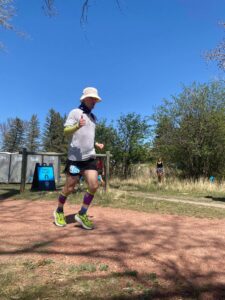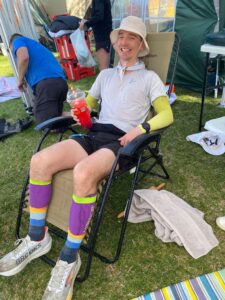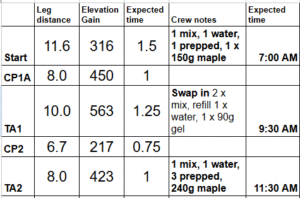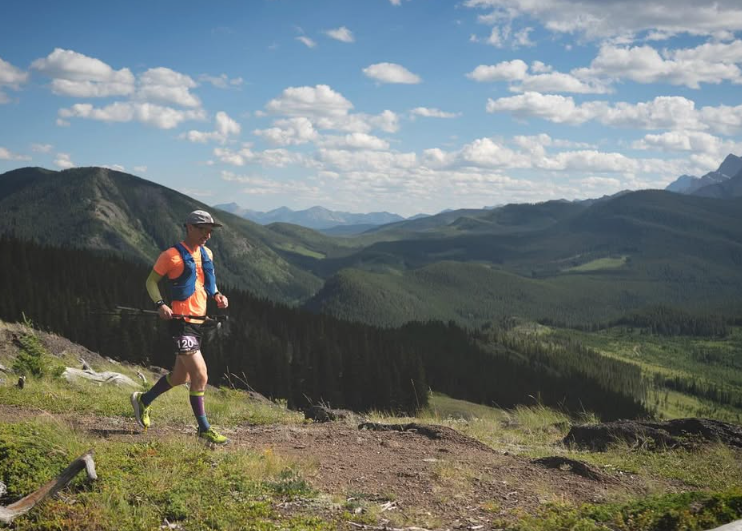360km of racing in 2.5 months
I’ve finished my two big races for the year, placing 3rd at the Oldman Backyard and 4th at Sinister 7 100 miler – which I’m super proud of! A big part of why I do these events is to learn from them, so here’s a bit of a summary about some of the lessons that I’m taking away from these events. Sorry it’s pretty long and rambling, you’ve been warned!
How to deal with the heat – Ice, ice, baby: Both of my races had temperatures over 30C which in the past has caused me a lot of problems. This year I was excited to see if I could do better. Firstly, coverage – I get way too hot running in a long sleeve or sun hoody, but found Craft arm sleeves worked really well, and when they are wet, they really do provide a cooling effect. They are also great for stuffing ice down, and mean I don’t need to apply sunscreen on my arms. I tried an ice bandana too and this works great for about 45-60mins before all the ice melts. For the backyard I got to refresh my ice every hour whereas at Sinister I stopped at every stream and splashed water on my arms and head. This kept me far more comfortable than in previous years. Also, bucket hats – my amazing wife and crew chief made a mid-run dash to Sports Experts and found one for me, I definitely will be wearing one on future hot days!


Heat training – I also tried some heat training this year, which involved wearing merino base layers on top and bottom, then a rain jacket and rain pants, and biff or toque whilst either running or cycling. I found this strangely enjoyable in an “overcoming the challenge of it” kind of way. I kept the effort easy for between 30-60 minutes and drank a lot of electrolytes prior, during and after. My heart rate was a good 10-15 beats per minute higher than usual for the pace I was doing. I also added in a couple of sauna sessions for extra measure as well. I think that even 2-3 of these sessions has a tangible benefit of acclimatizing to the heat, but that a full benefit is only reached if you do 10 sessions over 2 weeks. I did somewhere in the middle and believe it helped a bunch!
Test your gear on long runs – With my work and life schedule, I have an imperfect training plan where I don’t get out for as many long, long runs, but instead spread the training load over the week. This worked in lots of ways and I’m happy with my results – to have completed nearly 200km at the start of May and 100miles in mid-July means I was doing a lot right! But, I believe there are also some things you can only figure out through pressure testing in long efforts. For me, this was my shoes – I don’t feel like I had enough long, long runs to perfectly dial in my sock and shoe combos and in both races I tried a lot of shoes and still got blisters. Whilst not terrible, I know if I get this right I can wear one pair of shoes forever – I had no blisters after 10 days on the GDT! Likewise, for all your gear and systems, they need to be tested in your long runs. I was able to work out so many of the little details like knowing exactly what pocket of my pack everything should be in, to brush my teeth after 12 hours, and that late in long races I want to have both body glide and a tube of Voltaren with me for generous application on the fly! Sadly shoes and socks were just not one that I got figured out in time.
Strength Training – I firmly believe that the amount of strength training I did was the main limiting factor in both of these events. Leading up to the backyard I was doing 1-2 home workouts a week, which was good. Between the backyard and Sinister I did zero strength – which is not recommended! The result of this was that during my final laps at the Oldman, my hip got tighter and tighter, eventually leading to knee pain and an uneven stride. From the first leg of Sinister it was clear to me that my legs were not as strong as I’d like them to be on the ups and downs, and I was going to need to take care of them on all the descents – quick + light footwork, use poles on every descent, don’t go too fast. About halfway through the inside of my knee was hurting and for the final 40km it was pretty sore, especially on descents. Turns out I strained/inflamed my quad tendon, most likely from lack of glute strength, and am not yet cleared for running as I write this over two weeks after the event.
Ultimately I think I squeaked out of these events with close to the best possible results I could have hoped for with this amount of training, but it’s not something I can sustainably do long term. I’m going to need to find a way to incorporate more strength into my weekly schedule. I’ve done this in the past and it has helped me immensely, I think I have just been drawing down all my credit from the foundations I’ve built previously – time to build it back up again!


Food – During the backyard, I had too much variety and too many choices, which contributed to decision fatigue and not knowing exactly if I was eating enough or too much at times. At Sinister I tried to be really simple – tailwind, one type of gels, and maple syrup. I learnt that simple is great, but it didn’t give me a backup when these weren’t sitting well. In the future I’m going to go with a little more variety of flavours, and plan to have a little bit of ‘real food’ each hour to keep my stomach happy. If you’re lost on what food to have then the Bullseye plan is good to work through.
Motivation – Why do these things? It’s something we all need to figure out and keep close at hand during endurance events. I thought about this a lot before the backyard and had a whole page of different motivation strategies that I could try when the going got tough. Sadly, I totally forgot about them in the moment! A backyard ultra is perhaps the hardest format I’ve experienced when it comes to motivation. It’s kind of designed to test your resolve and does so in a relentless way. Whilst my body was hurting and I had some decent aches and pains, ultimately, I stopped because I couldn’t fathom starting another lap. I’d gotten ahead of myself instead of focusing on the here and now – this lap, this km, this step.
For Sinister I went back to what had worked for me well in the past – I want to experience this race, with all the ups and downs, and feel what it is like to do it. I wrote out a crib sheet with the distance and elevation gain between each aid station, and that is the only thing I focused on completing. I also re-listened to this podcast, which is one of my favourites about running mindset and the difference between suffering and running with ease. “Our goal is never to get good at suffering. Our goal is to suffer less under the same conditions, not to make running easier but to run with greater ease.”
There’s lots more I could say, and I’m sure other things will sift in and out over time. Let me know if you have any follow up questions or curiosities about this or anything else! What are some of your lessons that you want to take into your future training, races or adventures?

